Buyeo travel - South Korea, Asia
Buyeo, a historic city located in the Chungcheongnam-do province of South Korea. This charming city is situated in the southwestern part of the country, along the banks of the Geum River, and is surrounded by beautiful mountains and natural landscapes. As the capital of the Baekje Kingdom, which thrived from 18 BC to AD 660, Buyeo is home to numerous historical sites that reflect its ancient glory. The city is recognized as a UNESCO World Heritage Site, with many remnants of Baekje's architectural and cultural achievements.
Buyeo hosts various festivals, including the Lotus Flower Festival, which attracts visitors to enjoy the blooming lotus flowers and participate in cultural activities.
Craving an exceptional South Korea adventure? Explore our handpicked premium tours here for the ultimate experience.
Population: approximately 80,000 as of 2024.
Economy: Tourism is a significant part of Buyeo's economy, with the city's historical sites and cultural events attracting visitors from across South Korea and abroad. The Baekje Cultural Land, Gungnamji Pond, and annual Lotus Flower Festival are major draws for tourists.
Landmarks: Gungnamji Pond, Baekje Cultural Land, Busosanseong Fortress, Jeongnimsa Temple, Nakhwaam Rock, Seodong Park, Royal Tombs in Neungsan-ri
South Korea
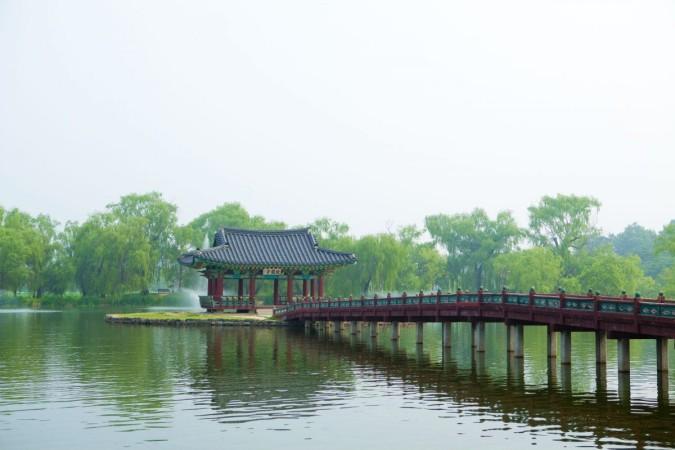
Overview of Buyeo
History & Culture Influence
Buyeo served as the capital of the Baekje Kingdom from 538 to 660 AD, known then as Sabi. This period marked the height of Baekje's power and cultural development, influencing neighboring kingdoms such as Silla and Goguryeo. The city was a center for trade, politics, and culture, contributing significantly to the development of Korean civilization.
Buyeo is home to several UNESCO World Heritage Sites that celebrate its rich history, including the Baekje Historic Areas. These sites attract both domestic and international tourists, fostering a sense of pride among locals and highlighting the city's cultural significance.
The Baekje Kingdom is also known for its exquisite artistry, particularly in pottery and metalwork. Artifacts such as the gilt-bronze incense burner, which reflects the sophisticated craftsmanship of the time, are significant cultural treasures that continue to influence Korean art and culture today.
Interaction with The Locals
The local community is characterized by its strong ties to the region's history as the former capital of the Baekje Kingdom, which influences both the cultural identity and social interactions of its residents. Visitors can expect to engage in cultural exchanges, especially during local festivals and events. The Lotus Flower Festival, for instance, is a vibrant celebration where locals actively participate and welcome tourists to join in the festivities. While many locals may speak some basic English, especially in tourist areas, learning a few simple Korean phrases can enhance interactions and show respect for the local culture. This effort is often appreciated by residents.
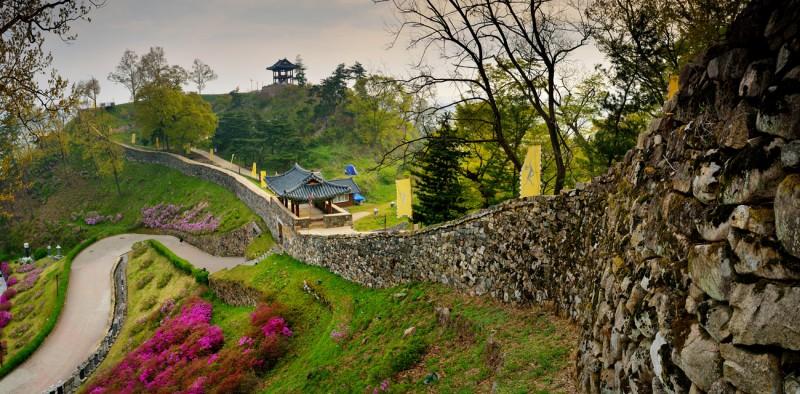
Baekje Historic Areas - © gather
Top attractions in Buyeo
Buyeo, a historical gem in South Korea, offers visitors a journey into the ancient Baekje Kingdom. Must-visit attractions include Baekje Cultural Land, where reconstructed palaces and temples bring history to life, and the scenic Gungnamji Pond, renowned for its stunning lotus flowers. For breathtaking views and a walk through history, Busosanseong Fortress provides an unforgettable experience of Korea’s cultural heritage.
Gungnamji Pond
Location: Seodong Park, south end of town near the General Gyebaek statue
Gungnamji Pond is a picturesque historical site, especially renowned for its vibrant lotus blossoms that bloom during the Seodong Lotus Flower Festival in July. A tranquil pavilion rests on an island in the middle of the pond, creating a serene escape surrounded by lush greenery, perfect for peaceful walks and nature photography.
Baekje Cultural Land
Location: 455 Baekjemun-ro, Gyuam-myeon, Buyeo, Chungcheongnam-do
Baekje Cultural Land offers visitors an immersive journey into the Baekje Kingdom’s past. This vast cultural complex features life-size reconstructions of ancient palaces, temples, and homes, along with a museum showcasing artifacts. It serves as both an educational hub and a historical treasure trove for those eager to explore Korea’s ancient heritage.
Busosanseong Fortress
Location: 31 Buso-ro, Buyeo-eup, Buyeo, Chungcheongnam-do
Perched on a mountain, Busosanseong Fortress offers stunning hiking trails with panoramic views of Buyeo and the surrounding landscape. Visitors can explore ancient pavilions and temples while learning about the fortress's role in Baekje's defense. The fortress also provides an idyllic setting for nature lovers and history enthusiasts alike.
Thinking of adding Goseong to your list? See why it stands out from other destinations right here in our article.
Jeongnimsa Temple Site
Location: 83, Jeongnim-ro, Buyeo-gun, Chungcheongnam-do
Once a grand temple during the Baekje period, the Jeongnimsa Temple Site now features a five-story stone pagoda, a masterpiece of Baekje architecture. The pagoda, known for its graceful design, stands as a testament to the kingdom’s craftsmanship and religious history, making it a must-visit for those interested in ancient Korean architecture.
Nakhwaam Rock
Location: Ssangbuk-ri, Buyeo-eup, Buyeo-gun, Chungcheongnam-do
Nakhwaam Rock is steeped in legend, marking the tragic site where Baekje’s royal women chose to leap to their deaths rather than face capture during the kingdom’s fall. The site offers breathtaking views of the Baekma River and holds deep historical significance, evoking reflections on the region’s storied past.
Seodong Park
Location: 169 Dongnam-ri, Buyeo-eup, Buyeo, Chungcheongnam-do
Seodong Park is a beautifully maintained space featuring lush gardens, walking trails, and sculptures that offer a perfect setting for relaxation. Popular during the blooming seasons, the park is an ideal spot for picnics or leisurely strolls amidst nature’s beauty.
National Museum of Buyeo
Location: 5 Geumseong-ro, Buyeo-eup, Buyeo, Chungcheongnam-do
The National Museum of Buyeo houses an impressive collection of Baekje-era relics, providing deep insights into the ancient kingdom's culture and history. Visitors can explore exhibits that range from pottery to royal artifacts, making it an essential stop for history buffs wanting to delve into Buyeo’s past.
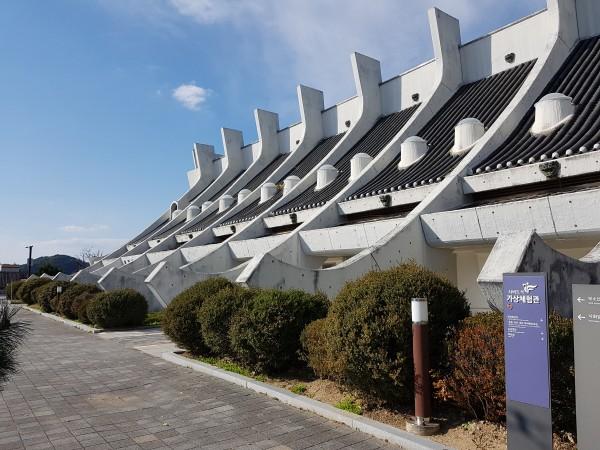
National Museum of Buyeo - © gather
Must-Try Dishes in Buyeo
When visiting Buyeo, don't miss the chance to try Kudurae Dolssambap, a nourishing meal of rice cooked in a hot stone pot, served with fresh vegetables and medicinal herbs for a truly authentic taste of the region. Another must-try is Yeonipbap, a traditional rice dish wrapped in lotus leaves, reflecting the royal heritage of the ancient Baekje Kingdom. For seafood lovers, Buyeo's spicy pollock roe stew offers a flavorful and hearty experience that highlights the region's coastal influences.
Kudurae Dolssambap
Kudurae Dolssambap is a signature dish of Buyeo, found along the popular Goodtrae Food Street. This hearty meal features rice cooked in a hot stone pot, served with an array of fresh vegetables and side dishes. The meal often includes medicinal plants, making it both a flavorful and nourishing experience that reflects Buyeo’s dedication to healthy, traditional cuisine.
Yeonipbap (연잎밥)
Yeonipbap, a traditional rice dish wrapped in fragrant lotus leaves, is a Buyeo specialty with roots in royal Baekje cuisine. Served with side dishes like fried fish and lotus roots, it carries historical significance, as lotus leaves were favored by ancient Korean royalty for their subtle flavor and symbolism of purity.
Ureong Ssambap (우렁쌈밥)
Ureong Ssambap showcases Buyeo’s unique take on ssambap (rice wraps) by featuring freshwater snails marinated in savory soybean paste. Typically served with a variety of fresh vegetables, this dish highlights Buyeo’s local ingredients and is a must-try for those seeking an authentic culinary experience.
Spicy Pollock Roe Stew with Rice
For seafood lovers, Buyeo’s spicy pollock roe stew offers a bold, flavorful experience. Made with rich pollock roe and cooked in a spicy broth, this dish is both comforting and satisfying. Often served with rice, it’s a favorite for those exploring Buyeo’s local seafood cuisine.
Ready to dive into the culture of Gongju? Check out our guide here for an insider's perspective on this amazing destination.
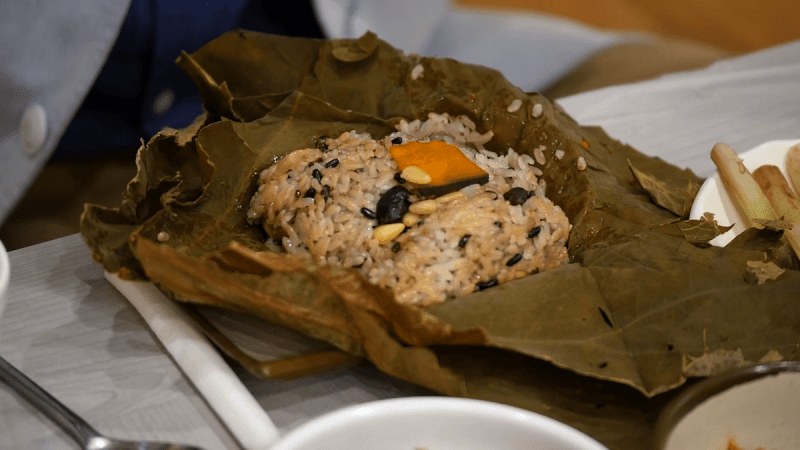
Yeonipbap - © EBS
Festivals & Local Celebrations
Buyeo Seodong Lotus Festival
Time of Year: Annually in July
The Buyeo Seodong Lotus Festival is a colorful celebration of the blooming lotus flowers at Gungnamji Pond, showcasing nearly 50 different varieties. Visitors can partake in lotus-themed activities such as craft workshops, tea ceremonies, and even kayaking. A night parade and light show add a magical touch, enhancing the serene beauty of the pond. Rooted in the love story of Prince Seodong and Princess Seonhwa, the festival offers a blend of nature, culture, and romance.
Buyeo Baekje Cultural Festival
Time of Year: Usually in October
This festival brings to life the rich legacy of the ancient Baekje Kingdom with traditional performances, historical reenactments, and lively parades. Visitors can immerse themselves in Baekje's history through cultural exhibitions, traditional crafts, and local cuisine. The event not only celebrates Buyeo’s historical significance but also fosters a deeper appreciation for Korean heritage, making it a must-visit for history and culture enthusiasts.
Buyeo Seodong Park Lantern Festival
Time of Year: July (during Seodong Lotus Festival)
As night falls, Seodong Park comes alive with beautifully illuminated lanterns during the Lantern Festival. Visitors can explore the park's enchanting lantern displays, participate in cultural activities, and enjoy live performances. The glowing lanterns create a dreamy atmosphere, offering a delightful experience for families and tourists seeking a picturesque evening in Buyeo.
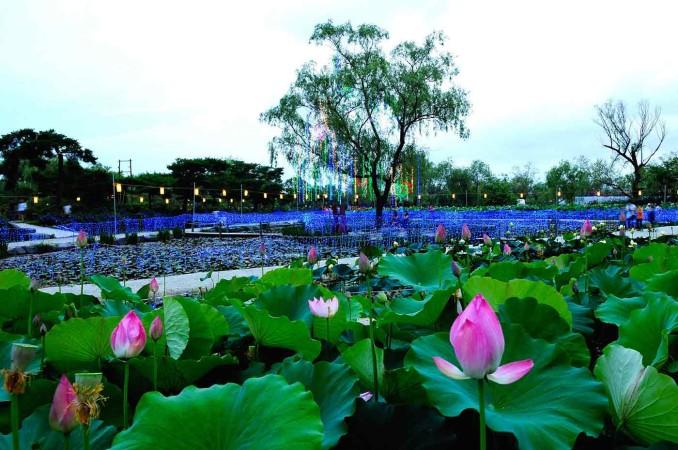
Buyeo Seodong Lotus Festival - © gather
What to Do in Buyeo
Gungnamji Pond
Take a leisurely stroll around Gungnamji Pond, known for its beautiful lotus flowers that bloom in July during the Seodong Lotus Festival. The pond offers a serene environment for relaxation and appreciating nature.
Baekje Cultural Land
Explore the Baekje Cultural Land, an open-air museum that showcases the history and culture of the Baekje Kingdom. Visitors can see reconstructed palaces, temples, and participate in cultural activities to gain insights into Buyeo's rich heritage.
Busosanseong Fortress
Hike up to Busosanseong Fortress for panoramic views of the surrounding landscape. The fortress offers scenic walking trails and the opportunity to learn about Buyeo's military history.
Buyeo Seodong Lotus Festival
Visit Buyeo during the annual Seodong Lotus Festival in July to experience the vibrant celebrations. Attend cultural performances, participate in lotus-themed activities, and enjoy the stunning views of the blooming lotuses at Gungnamji Pond.
Amphibious Bus Tour
Take an amphibious bus tour that combines land and water exploration. The tour takes visitors along the Baengmangang River, offering views of historical sites like Goransa Temple and Nakhwaam Rock from the water.
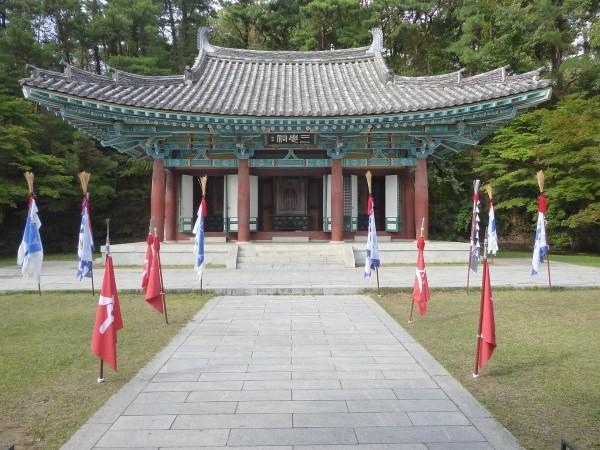
Sanseong Fortress - © gather
Weather in Buyeo: Best Time to Visit
Buyeo experiences a humid subtropical climate, characterized by four distinct seasons. Here’s an overview of the weather patterns, average temperatures, rainfall, and the best time to travel to help visitors pack appropriately.
Average Temperatures
Spring (March to May): Average temperatures range from 8°C (46°F) in March to about 20°C (68°F) in May.
Summer (June to August): Average highs can reach between 26°C (79°F) and 30°C (86°F), with July being the hottest month.
Fall (September to November): Temperatures range from about 20°C (68°F) in September to 10°C (50°F) in November.
Winter (December to February): Average temperatures drop to around -1°C (30°F) to 5°C (41°F), with January being the coldest month.
Rainfall
Rainy Season: The majority of rainfall occurs during the summer months, particularly in July and August, which can see significant precipitation due to the monsoon season. Average monthly rainfall can exceed 200 mm during these months.
Dry Months: The months of December to February typically experience lower rainfall, making winter drier compared to other seasons.
Best Time to Travel
Spring (April to June): This is one of the best times to visit Buyeo, with pleasant temperatures ranging from 15°C to 25°C (59°F to 77°F) and blooming flowers, especially during the Seodong Lotus Festival in July.
Fall (September to October): Another ideal time to visit, with mild temperatures and beautiful autumn foliage. Average temperatures during this period are comfortable, typically ranging from 15°C to 22°C (59°F to 72°F).
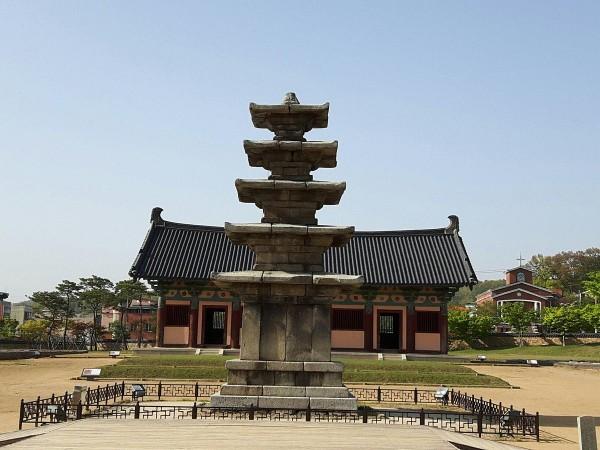
Jeongnimsa Temple Buyeo - © gather
Culture Etiquette in Buyeo
When visiting Buyeo, understanding local cultural etiquette and customs can enhance interactions with residents and create a more enjoyable experience. Here are some important points to consider:
Respect for Traditions
When visiting temples or historical sites, it's essential to dress modestly and show respect for the sacred surroundings. Be mindful to remove your shoes when required, and keep your voice low, especially in places of worship, to maintain the serene atmosphere.
Greetings
In Korea, a polite greeting goes a long way. A slight bow or saying "Annyeonghaseyo" (Hello) is a thoughtful way to show respect, especially to elders. This gesture is a key part of Korean culture, emphasizing politeness and respect.
Dining Etiquette
When sharing a meal, wait for the eldest person to begin eating before you start. It’s customary to use both hands when passing or receiving dishes or drinks, and avoid sticking your chopsticks upright in your rice—it’s considered bad luck as it resembles a funeral practice.
Photography Etiquette
Before taking photos of people, especially in rural areas or during cultural events, it's polite to ask for permission. This gesture respects local customs and personal privacy, ensuring a more positive interaction.
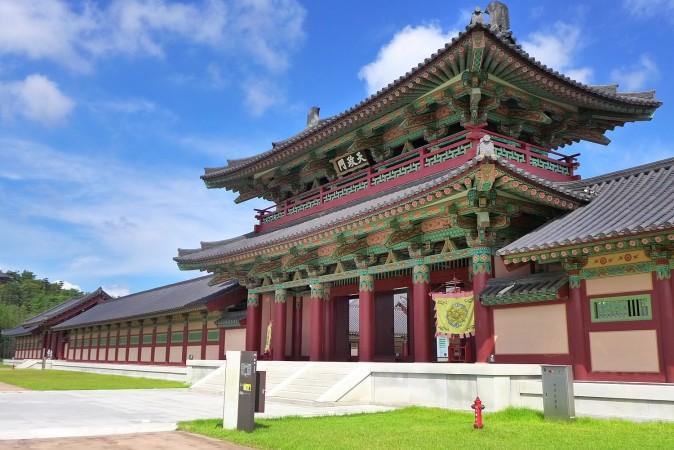
Baekje Cultural Festival - © gather
Essential Travel Information
Getting to and around Buyeo is relatively straightforward, with several transportation options available for visitors.
Airport Transfers
- From Incheon International Airport (ICN): Travelers can reach Buyeo by taking a bus or train from Incheon Airport, usually via Seoul. The total journey takes about 3.5 to 4 hours, with costs ranging from $25 to $35, depending on the mode of transport.
- Direct Transfers: For a quicker and more comfortable option, private transfers are available from Incheon Airport to Buyeo, taking around 2 to 2.5 hours. However, this service is pricier, starting at approximately 215 EUR.
Public Transit
- Buses: Buyeo is well-served by intercity buses from major cities like Seoul and Daejeon. The Buyeo Intercity Bus Terminal provides regular services, making travel to the city easy.
- Trains: Though Buyeo lacks a direct train station, visitors can take a train to Gongju Station and transfer to a local bus or taxi to reach their destination.
Taxis
Taxis: Local taxis are readily available and offer a convenient way to get around Buyeo. They operate on a metered fare system, and the fares are generally affordable for common routes within the city.
ATM Services
- Availability: Buyeo has several ATMs, including those from major banks, that support international cards, providing easy access to cash for travelers.
- Banking Facilities: Many hotels, such as Lotte Resort Buyeo, offer ATM services on-site, ensuring guests can easily access banking services without leaving their accommodations.
Accommodation Choices
- Lotte Resort Buyeo: This luxury resort offers modern amenities like a restaurant, fitness center, and spa. It’s conveniently located near Buyeo's key attractions, making it an excellent base for exploring the area.
- Buyeo Hanok Village: For an authentic cultural experience, guests can stay in traditional Korean hanoks, providing a unique opportunity to appreciate traditional architecture and local culture.
- Hotel W Buyeo: A modern hotel offering comfortable rooms and essential amenities, suitable for both business and leisure travelers, with easy access to local attractions.
- Buyeo Guesthouse: A budget-friendly guesthouse with dormitory and private rooms, providing a cozy, social atmosphere for travelers looking for an affordable yet comfortable stay.
Articles for you

Experience Aboard The RV Indochine II - A Mekong Cruise With Tweet World Travel
The RV Indochine II is a luxury river cruise ship, offering an unforgettable journey through many attractions along the Mekong River. Built in 2017, this upscale vessel combines colonial elegance with modern conveniences to create a comfortable yet stylish environment for its crew and passengers. The ship’s intimate size makes it ideal for those seeking a more personal cruising experience while exploring Vietnam and Cambodia rich culture, scenery, and heritage. Whether you're gazing at the landscape from your private balcony or enjoying authentic local cuisine, RV Indochine II promises an exotic adventure like no other.

Witness Stilt Fishing In Sri Lanka: An Eco-Tourism Experience
Sri Lanka, renowned for its stunning beaches and rich cultural heritage, harbors a unique tradition that has captivated travelers for centuries: stilt fishing. This ancient practice, passed down through generations of coastal communities, blends artistry with necessity, offering a glimpse into a way of life intimately connected to the island's coastal rhythms. Stilt fishing in Sri Lanka isn't merely a means to catch fish; it's a cultural emblem, embodying the resilience and ingenuity of Sri Lanka's fishing communities.

Make Your Trip Stress-Free With The Tweet Trip App
Embark on your next adventure with confidence by downloading the Tweet Trip App, available for both iOS and Android. This essential travel companion allows you to view your detailed itinerary, stay connected with your tour guide and fellow travelers, receive real-time updates, and provide feedback effortlessly. With features like in-app messaging, emergency assistance, and location sharing, the Tweet Trip App ensures you travel smarter, stay connected, and enjoy a seamless, worry-free journey. Get started today and make the most of your travel experience with Tweet World Travel.

Pedal Through Paradise: Unveiling Cambodia's Hidden Gems on Two Wheels
The gentle whir of bicycle wheels mingles with the distant chants of monks as you glide past emerald rice paddies stretching to the horizon. This is Cambodia - a sensory explosion waiting to be experienced on two wheels. At Tweet Tours, we believe there's no better way to immerse yourself in the Kingdom of Wonder than by bicycle.
Cambodia isn't just a destination; it's a living, breathing tapestry of ancient wonders, natural beauty, and vibrant culture. Our carefully crafted cycling tours take you beyond the typical tourist haunts, offering a unique perspective on this captivating country. Ready to clip in and discover the magic of Cambodia? Let's ride!

Trekking in the Himalayas: A Journey Through Nepal's Majestic Peaks
The Himalayas rise from the earth like colossal guardians, their snow-capped peaks piercing the sky in a display of nature's raw power and beauty. Nepal, nestled at the heart of this mountain range, serves as the gateway to some of the most breathtaking trekking experiences on the planet. Here, the air is crisp and thin, filled with the promise of adventure and the whispers of ancient tales.
With Tweet Tours, as you set foot on these hallowed trails, you're not just a traveler - you're a modern-day explorer, following in the footsteps of legendary mountaineers and age-old traders. Each step takes you further into a world where nature reigns supreme and human resilience is tested against the backdrop of some of the world's highest peaks.
From the moment your boots touch the ground in Kathmandu, you'll feel the pull of the mountains. The bustling streets of the capital, with their sensory overload of sights, sounds, and smells, soon give way to serene mountain paths where the only soundtrack is the crunch of gravel underfoot and the distant tinkling of yak bells.

Exploring Mui Ne's Wonders: Unique Attractions & Local Dishes
Nestled along the southeastern coast of Vietnam, Mui Ne emerges as a captivating gem, blending natural wonders with cultural richness. Renowned for its stunning landscapes and unique attractions, Mui Ne beckons travelers seeking both relaxation and adventure in equal measure. Mui Ne's renowned beach dunes, bustling fishing towns, and excellent local food await exploration at every turn.
The allure of Mui Ne lies not only in its pristine beaches and crystal-clear waters but also in its diverse range of activities catering to every traveler's whims. Whether you're drawn to thrilling water sports like kitesurfing and windsurfing on its dynamic shores or seeking tranquility amidst the picturesque Fairy Stream, Mui Ne promises an unforgettable journey filled with discovery.
